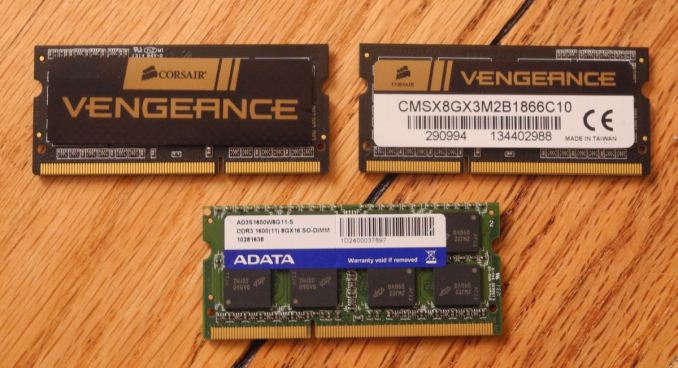GIGABYTE BRIX Pro: A First Look at the Intel i7-4770R with Iris Pro HD 5200
by Ganesh T S on January 7, 2014 8:00 PM EST
We have had a quick glance at what the Core i7-4770R is capable of in the BRIX Pro. The initial look has given us various avenues to explore in the second part of the review. After getting back from CES, our first plan is to investigate whether any real-world workloads can cause the unit to throttle. The WLAN card is also pending investigation. At first glance it appears to be a 1x1 802.11ac card from Realtek, but more tests need to be done in order to get an idea of the WLAN performance.
The unit does offer the DIY crowd a little bit of flexibility in fine-tuning the performance. With judicious choice of DRAM and SSD / HDD storage, it is possible to adapt the BRIX Pro to one's requirements. The effect of the choice of DRAM modules can't be overstated in determining the performance of the system. We plan to benchmark the unit with a couple of additional DRAM modules (varying in size and speed). The Corsair Vengeance SODIMMs capable of running at 1866 MHz and the 8 GB per stick ADATA stick capable of running at 1600 MHz are already with us. The memory slots in the BRIX Pro are tuned for DDR3L (1.35V DRAM). It will be interesting to watch what speeds can be hit with these memory modules.
Additionally, as readers requested in our NUC review, we plan to add some basic gaming benchmarks to the mix. Anand has already covered the gaming performance of the Iris Pro HD5200 in detail before, but this will give some additional context for the BRIX Pro as a gaming machine.
Gigabyte's press release for the BRIX Pro went out yesterday. The product has two SKUs, one based on the i7-4770R, and the other based on the i5-4570R. Both CPUs have 65W TDPs, and hence there should really be nothing different between the two versions other than the CPU itself. One of the interesting aspects in the press release was the reference to 64 MB of eDRAM on the Iris Pro HD 5200. Anand's testing of the i7-4950HQ estimated the amount of eDRAM to be around 128 MB as per Intel's specifications. However, Gigabyte continues to hold on to the 64 MB eDRAM number for the i7-4770R and the i5-4570R even after a request for comment was sent. This is one additional aspect that we would like to evaluate in our second part of the review.
The final aspect that we are covering today is pricing. The i7-4770R and i5-4570R cost $392 and $288 respectively (as per the ARK pages). They are only available to OEMs. The MSRP for the GB-BXi5-4570R is $529, while the GB-BXi7-4770R comes in at $649. Considering that no other vendor has brought out a i7-4770R system, Gigabyte can charge a premium and still get away with it. Given the high price demanded by Intel for the CPU alone, the end pricing of the systems don't appear outrageous.
The BRIX Pro is a very exciting system and will definitely energize the NUC / UCFF category. The only worrying point is the thermal performance. Would it have been better for the 47W TDP version (i7-4950HQ) to come in this chassis, with the 65W TDP version sacrificing some of the compactness for a better cooling system? At this point, we don't want to jump to conclusions before digging more into the throttling behaviour. Stay tuned for further coverage towards the end of this month.











98 Comments
View All Comments
mfoley93 - Tuesday, February 11, 2014 - link
The issue with the AMD APUs is that they have used different GPUs accross the line, whereas Intel only has 3 active GPU SKUs. So while the GPU in the 95 Watt A-10 7850 labeled only as R7 would likely smoke Iris Pro/HD 5200, the GPU in the 65 Watt A-8 7600 may only perform similarly to the Iris Pro when it finally launches. AMD using different GPUs may have changed though, since they haven't released the A-4, A-6, and A-8 models yet.mfoley93 - Tuesday, February 11, 2014 - link
EDIT:A quick jaunt over to AMD's website shows that their tendency to use different GPUs has not changed. Even though there is no info about the A-8 7600, one can see that the A-10 7700K has two compute units disabled on the GPU compared to the 7850K.
mikk - Tuesday, January 7, 2014 - link
The GPU is probably comparable or maybe slightly slower than this Iiris Pro. It has more Gflops as well as more bandwidth with its edram.jeffkibuule - Tuesday, January 7, 2014 - link
You need to go read the Iris Pro graphics review again to see why just measuring GFLOPs doesn't give you the result you seem to expect.ryrynz - Tuesday, February 4, 2014 - link
Funny cos, they're gonna make you wait.XZerg - Tuesday, January 7, 2014 - link
I am waiting to see the Zotac IQ01 availability and benches. 4770T in a small enclosure.Daisho11 - Tuesday, January 7, 2014 - link
I really wish they would make one of these with the PSU built in, instead of having a power brick hanging off the back.patterson32 - Tuesday, January 7, 2014 - link
At least it helps with heat minimization. Positive thoughts.MikeMurphy - Tuesday, January 7, 2014 - link
This is a tech site. Instead of telling us the cooling is insufficient, I hope you'll show us the config and explore replacement fans etc. Are the cooling mounts LGA standard?patterson32 - Tuesday, January 7, 2014 - link
I'd like AT to explore quieter replacement fans as well. Fanless cases might be okay too but they'll probably cost a lot compared to the system just like the NUC ones.